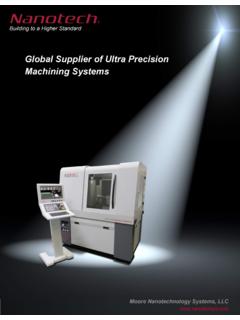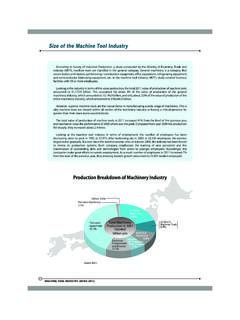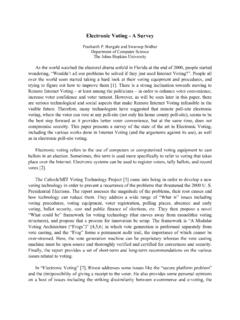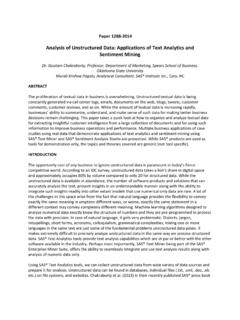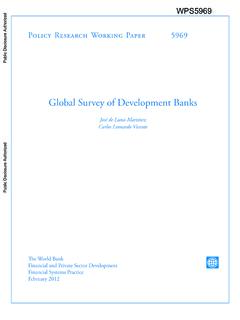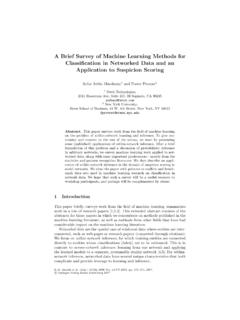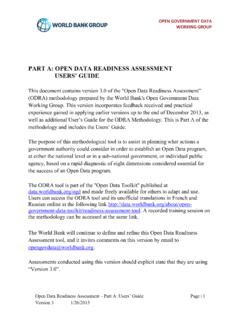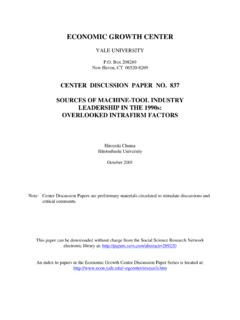Transcription of Ultra-precision Machining Systems; an Enabling Technology ...
1 1 Ultra-precision Machining Systems; an EnablingTechnology for Perfect SurfacesGavin ChapmanMoore Nanotechnology Systems LLC, PO Box 605, 426a Winchester Street, Keene,NH 03431, USAA Historical OverviewThe Technology of Ultra-precision Machining , spanning almost three decades, has onlyin recent years experienced major advances in machine design and, subsequently,performance and productivity. In the 1970 s, Ultra-precision Machining techniqueswere successfully adopted for the manufacture of computer memory discs used inhard drives, and also photoreceptor components used in many photocopier machineand printer applications. Such applications required extremely high geometricalaccuracies to be achieved, in combination with super smooth surfaces. Thesesurfaces were found to be most effectively manufactured by single point diamondturning, as opposed to multiple processes such as Machining , lapping, and machinery developed for such applications typically required only one linear axisof motion, to generate a cylindrical or plano form.
2 The machines often utilized an airbearing work holding spindle, and linear slide, mounted to a granite base. Machinerysoon evolved into multi-axis systems, with major advances seen in CNC control, andposition feedback Technology . An example of one of the early multi-axis machines isshown below. An early multi-axis single point diamond turning machineDuring this era, the use of Ultra-precision Machining continued to revolve around thecore Technology of single point diamond turning. As such, the process was limited tothose materials that could be machined by a diamond tool . These materials includemost all Face Centered Cubic elements, fundamentally non-ferrous alloys such as2 Aluminum, Copper, Nickel, Gold, Brass, & Bronze. In addition, it was found thatdiamond Machining was well suited to cutting crystal materials such as Germanium,Silicon, Zinc Sulfide & Selenide, as well as polymers such aspolymethylmethacrylate, polystyrene, and is not surprising that applications soon developed for defense optics, in addition tocommercial products.
3 The emerging technologies of infrared night vision systemsrequired a range of reflective components such as toroids, polygons, frame mirrors,and cold shields. These were typically machined in aluminum alloys such as addition, lenses in Germanium were required for windows and lenses. Designerswere now making use of aspheric geometries to reduce spherical aberration, minimizethe number of elements thus reducing weight, and ultimately reducing the amount ofcostly Germanium systems operating at different wavelengths utilized Silicon lens and windowelements. Silicon had, and has to this day, distinct cost saving benefits, and isconsiderably lighter than Germanium. Silicon is however extremely difficult todiamond machine , primarily due to it s hardness, and therefore did not proliferate towidespread use with aspheric geometries.
4 With today s machine Technology ,incorporating stiffer axes, smoother drives, and more precise spindles, siliconaspherics can be single point diamond turned more effectively than ever. At the sametime, deterministic micro-grinding developments at establishments such as the Centerfor Optics Manufacturing at the University of Rochester allow Silicon aspherics to bedeterministically ground to a precision that often requires no further ApplicationCommercial applications for single point diamond turning developed throughout theUnited States, Europe, and interestingly, later in the Far East. The boom in consumerelectronics, and a certain dependence on optics technologies has fueled a massivegrowth in the use of aspherics, and other rather non-conventional geometries. Opticaldesign software has allowed designers to optimize system performance in all respectsby building in complex, yet manufactureable surface forms.
5 In parallel to machinerybeing developed for general sale on a commercial basis, certain leading companies,such as Philips of The Netherlands, developed highly innovative machiningtechnologies in house , in order to exploit opportunities in, for example, theCompact Disc player market. Many of these applications however required optics invast numbers and so individual diamond Machining was not cost effective. Grindingprocesses were therefore developed that utilized basic Ultra-precision machiningpractices, while adopting a fixed abrasive wheel in place of the single point diamondtool. This, in combination with injection molding, and hot pressing, was adopted toproduce the optics required in the many consumer electronic products that we nowtake for grinding process allowed mold inserts to be generated with primarily asphericforms, but did not allow more complex diffractive geometries due to the restrictive3diameter of the grinding wheel.
6 Mold inserts manufactured from harder, and morebrittle materials are still commonly used today. Materials such as tool steels,Tungsten Carbide, and Silicon Carbide can be consistently ground to surface texturesbetter than 10nm RMS, and figure accuracies as low as /10. CD & DVD Pick-up LensesMore Recent DevelopmentsIt is in the past 10 years however that some major advances in controls, feedbacksystems, servo drives, and general machine design and construction have evolved tothe point where today s Ultra-precision Machining systems are more productive, moreprecise, and lower in price. This has resulted in a proliferation of their use throughoutthe world for a wide range of s single point diamond turning machines have evolved to utilize a host of newtechnologies. When combined in a regimented manner, these allow surfaces to besingle point diamond turned in all the aforementioned materials, to a surface textureoften as low as 2nm RMS, and with figure accuracies, low in absolute error, andexhibiting very low slope characteristics.
7 Many of these Enabling machine features are listed below. Epoxy granite or natural granite machine bases, for thermal and mechanicalstability, damping characteristics, lower center of mass, and design flexibility. Optimally located air isolation, for optimized servo performance, and enhancedvibration isolation. Hydrostatic oil bearing box-way linear axes, for enhanced damping, smoothnessof motion, geometrical accuracy, and wear free operation. DC linear motors provide rapid feed rates, smooth, wear-free, and non-influencing motion, and superb longitudinal dynamic stiffness. High-speed air bearing spindles allow faster feed rates, therefore reduced cycletimes, as well as smooth rotational motion, high load capacity, and High speed CNC controls, utilizing PC Technology , to allow networking, hugepart program storage, and utilization of 3rd party programs.
8 Also to facilitate theuse of advanced drive and feedback devices to improve workpiece accuracy. High-resolution linear scales, providing precise axis position feedback fornanometric incremental moves, improved dimensional stability, and ultimately,consistent and precise geometrical accuracy. On machine workpiece measurement and error compensation systems allowresidual workpiece errors to be assessed, and practically eliminated, providingthey are of a repeatable current state-of-the-art single point diamond turning machine is shown below. Thishas the spindle mounted on the X-axis, and would typically have the diamond turningtool mounted on the Z-axis. The Axes are mounted in a classic T configuration,and as such allows any rotationally symmetrical part to be machined. Current state-of-the-art single point diamond turning machine (base & slides)The Need to GrindSingle point diamond turning machines are often provided with add-on grindingattachments, to extend their usage to those materials that are not diamondmachineable, as described earlier.
9 This approach provides for an extremely flexiblemachining system , but extreme care must be taken at the earliest design stage toensure that the stiffness of the machine is apt to handling the increased grindingforces, and that the guarding and coolant containment measures are up to theincreased demands. Due to the limited space available, the grinding attachment mayalso be limited to a single spindle. This might then require wheels to be changedmore often than desired, for rough grinding and finish grinding applications revolve purely around the grinding of mold inserts, or for the directgrinding of glass aspherics, then a dedicated grinding machine may be moreappropriate. This type of system will be designed to handle the increased forces andcoolant volumes, and will likely incorporate both a rough and finish grinding spindlefor improved productivity.
10 The workpiece might also be mounted in a vertical axisorientation that is familiar to many glass processing operatives. The ability to directlygrind precision aspheric glass lenses economically has opened a floodgate ofapplications in both commercial and defense example, current Technology is able to take a 50mm diameter rough glass moldingor pre-generated blank, and finish grind to a /2 figure and 3nm RMS finish, within15-30 minutes. The specific accuracies and cycle times are of course very dependenton specific glass types, such is the process-related nature of grinding. View of a typical aspheric grinding process, and resulting figure accuracy Freeform GeometryA common limitation of the previously mentioned single point diamond turning andgrinding machines, is their inherent ability to generate only rotationally symmetricalsurfaces.
